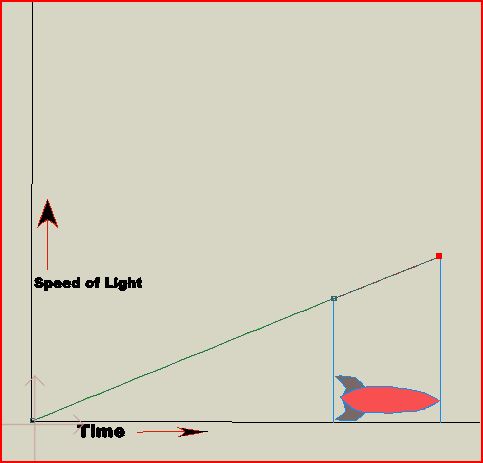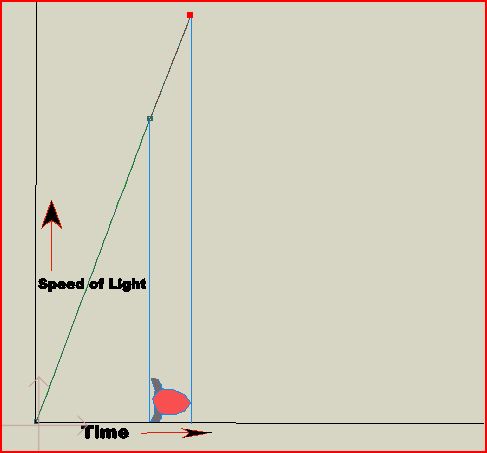Relativity... is mass the same as density?
 lardom
Posts: 1,659
lardom
Posts: 1,659
I'm trying to get a better grasp of the theory of relativity and I know there are people here who can help. With a graph it is easier for me to see that an object traveling at close to the speed of light shortens in the direction of travel. The rocketship in the second graph appears to squish as if the atoms were being bunched up suggesting that mass refers to the density of matter.
Graphically, at the speed of light time is eliminated and mass would appear to be infinite. (I've never tried to understand the Lorentz equations.)
As the speed of light is approached does the weight of the rocketship change as its mass increases? How is mass defined and what units are used when calculating it?
Graphically, at the speed of light time is eliminated and mass would appear to be infinite. (I've never tried to understand the Lorentz equations.)
As the speed of light is approached does the weight of the rocketship change as its mass increases? How is mass defined and what units are used when calculating it?




Comments
http://www.physics.ucla.edu/k-6connection/Mass,w,d.htm
DJ
But here's the complicating factor. Objects can not accelerate to the speed of light. So an object moving at relativistic speeds increases mass to compensate for additional acceleration. So would the travelers in the rocket notice their increased mass?
- Density is the mass per unit volume. This is a function of the atomic structure of the element.
- Weight is the force exerted by a mass as a result of gravity or acceleration.
An object travelling at relativistic velocities does not gain in mass by gaining more "stuff", but by the stuff itself becoming more massive. Have I confused you completely yet? This is why we are looking for the theorized "particle" that gives matter the property of mass.
If you want to get a really good, hands-on feel for how this whole increasing mass at velocity thing goes, something you can remember forever and even teach to others, try this:
Get a fairly good size rare-earth magnet - something around 1/3 cm thick and maybe 2 cm long, then go find a flat, smooth aluminum surface at least 5mm thick (the thicker the better to get the effect) by at least a half a meter square for plenty of playing room. I find that street signs (stop, yield, etc) are handy for this if you have one close by your home. (Leave it on the pole... :-) )
Place the magnet on the aluminum surface and move it SLOWLY. It will feel like - nothing really, just like you are sliding one piece of metal over another. Now move it quickly - and something changes! The faster you move it, the harder it is to move it! At first, it slides around with no resistance, but move it fast and it feels like you are moving it through peanut butter.
That's what happens when you accelerate mass toward the speed of light. At low speeds, stuff just slides around, but at around 75% C you start getting some very noticable increases in energy required to push the mass at the same accelerational rate.
The theory is that, like the magnet and aluminum, there is an interaction of some sort between the massive "particle" component in matter, and something else in the fabric of space, as I understand it, anyway.
I hope this helped some and didn't just confuse more! :-)
Dave
PS, By the way, the reason the magnet & aluminum behave as they do is because a current develops in the aluminum from the moving magnetic field, and that current interacts with the field in a manner that opposes the movement of the magnet. You can try it also with a RE Magnet ball and an aluminum channel or tube... the ball rolls really slowly down - very strange and counterintuitive to watch.
Wikipedia seems to have a pretty good article on this. Note the comments on rest mass vs. invariant mass.
http://en.wikipedia.org/wiki/Mass
Indeed, if you were to be in a craft travelling at near C, to you, you wouldn't feel any more massive... unless you were eating a big meal while you flew! :-)
The real issue with this form of travel is the time problems - to go anywhere at any significant distance might not take long from your perspective, but when you get back, it turns out you've been gone a LOT longer than your watch recorded! Plus, in reality, C is pretty slooowwwww when you really look at things. Even the nearest stars - the Centauris - take light 4+ years to get there. On a universal - or even only a galactic - scale, that's unreasonably slow.
Much better to warp space and move that around you, than to try to zip your massive self through it. Space has no mass (but mathematically, it can be proven that each point in space contains infinite mass and energy, if you're a chromodynamics fan) so you can move space with infinite velocity... theoretically, of course!
Dave
The math used in General Relativity is very difficult (Einstein had to get help with it) but the math needed in most Special Relativity is just algebra (really messy algebra with lots of square roots).
While the apparent mass of an object traveling at high speeds with respect to the observer's reference frame seems to increase, physicist usually refer to the increase in "beta" (one of the terms in the relativistic equations (I think it's v^2/c^2)). And as has been stated, an observer traveling at high speeds would not notice an increase in mass. To him/her the rest of the universe is traveling at high speed and they are at rest (hence speed is relative with respect to who's doing the observing).
One of the strangest consequences of Special Relativity to me is the loss of synchronicity (there is no universal "now").
lardom said:
All the strange things that happen to space and time are required to make the speed of light the same for all observers. Einstein was some sort of Einstein to be able to make this leap in thinking.
If the speed of light were 30 mph all these weird phenomena would be "common sense" to us.